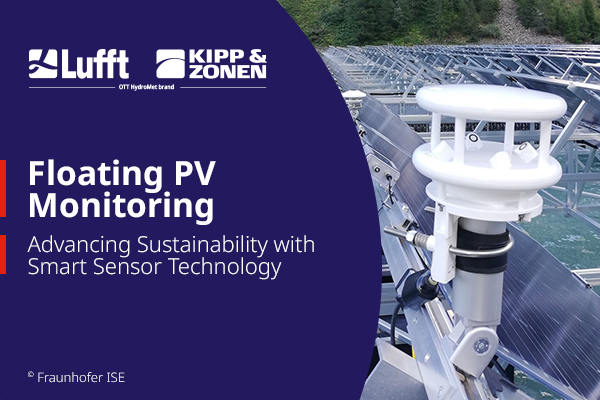Demanding and complex measurement tasks can only be tackled successfully with high-precision devices. Aside from measurement, storage and transmission of environmental variables, the analysis of collected data constitutes another extremely important aspect of data processing. Lufft developed the SmartGraph3 software to ensure the ongoing transfer of measurement results and additionally offers the MCPS7 software for special applications.
Photo-Credit: Stock-Photo – File #18250663
Demanding and complex measurement tasks can only be tackled successfully with high-precision devices. Lufft, the measurement and control equipment company, has firmly established its name by consistently providing top quality for 130 years. Aside from the measurement, storage and transmission of environmental variables, the analysis of collected data constitutes another extremely important aspect of data processing. There are several reasons for the documentation of measurement data: long-term observations facilitate the early recognition of changes and make it possible to react immediately to short-term variations. The measured data, including temperature, humidity and airflow values, is presented and analyzed by means of a client/server system connected to the measurement device; thus, users are only provided with data that is relevant to them. Lufft developed the SmartGraph3 software to ensure the ongoing transfer of measurement results and additionally offers the MCPS7 software for special applications.
» Management and archiving of data: SmartGraph3 for handheld measurement devices and data loggers by Lufft
Lufft’s SmartGraph3 software manages and archives measurement data provided by Lufft’s handheld instruments such as the all-rounder, XA1000, and data loggers, such as the OPUS20 series. Depending on the specific device, the application manages the data either directly in real time or by periodically retrieving values from the measurement network.
The Windows-compatible SmartGraph3 software, which is included with the delivery of each handheld measurement device and data logger, offers a clearly laid out presentation and the straightforward acquisition of all measurement data. Data analysis is carried out via a USB interface. The program supports the execution and logging of measurements in parallel to the retrieval of data, i.e. by means of the included “recorder mode”. The table-based and graphical presentation of measurement values, the comprehensive printing and export functions as well as the zoom and scroll tools for targeted graphical evaluation are all part of the standard functionality of the SmartGraph3 monitoring software.
Diagrams with measurement values in the software SmartGraph3
In contrast to the handheld measurement devices, the OPUS20 data logger is automatically recognized and added as a network device by the computer. The network function allows the simultaneous analysis of as many OPUS devices as desired. You can also print out the device configuration to verify that the installation parameters are correct. The functions for the analysis of measurement data provided by the software here are identical to those for handheld measurement devices. One difference, however, lies in the fact that the alarm boundaries can be managed for variable periods in line with measurement data. In this way, it is possible to track alarm boundary changes at any time.
» A specialist in its field: MCPS7, compliant with 21 CFR Part 11
If the range of features provided by SmartGraph3 turns out to be inadequate for a certain special use of the OPUS20 series, you can now additionally take advantage of the MCPS7 software. Here, you can customize a range of features from configuration, data storage and transfer options all the way to the setup of alarms, the export of measurement values, user administration, visualization and reporting. This software is a true specialist in its field and serves to fulfill the individual requirements of customers, especially with regard to the real-time retrieval of measurement data. It supports the collection of data at single-second intervals and the generation of averages. In the process, raw data is transferred to the computer center, which simultaneously manages large amounts of data and clearly arranges various measurement variables and locations. A mere simplified presentation of the result is never sufficient here – the user interface displays the entire data in a well-structured fashion and can be operated intuitively by the user. The reporting system, with the capability to generate batch reports, should be mentioned here as one big advantage in comparison to SmartGraph3. In addition, the web server integrated in the MCPS7 software makes all pre-defined diagrams visible to other users on the intra- and extranet.
Different user-interfaces of the software MCPS7
MCPS7 was developed to meet the most stringent monitoring requirements in the world. The software was certified according to Title 21 CFR Part 11. The 21 CFR Part 11 regulation of the American FDA (Food and Drug Administration) entered into force in 1997. It defines different acceptance criteria for the use of electronic records. Accordingly, the latter must be just as trustworthy and reliable as, and equivalent to, traditional records on paper. The MCPS7 software fulfills these statutory conditions completely, because the usage of computer systems in certain regulated areas – e.g. in the pharmaceutical industry – is subject to meeting the requirements of the licensing authorities. One result of the development of the monitoring software according to this law is that the pharmaceutical industry has largely dispensed with expensive paper documentation. Consequently, the associated reduction in costs has contributed towards the acceleration of development processes and an increase in productivity thanks to the faster access to documents. And this is another area, where Lufft’s function as an innovator and expert in industrial data collection is very much in demand.





